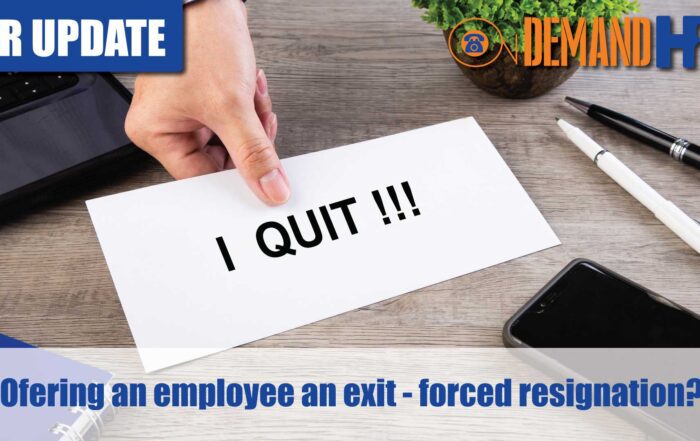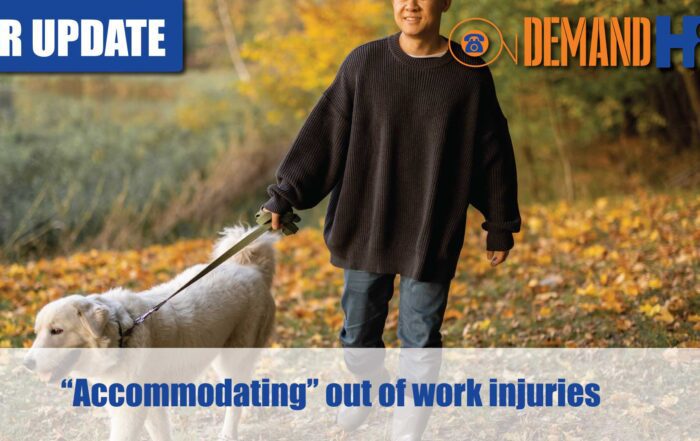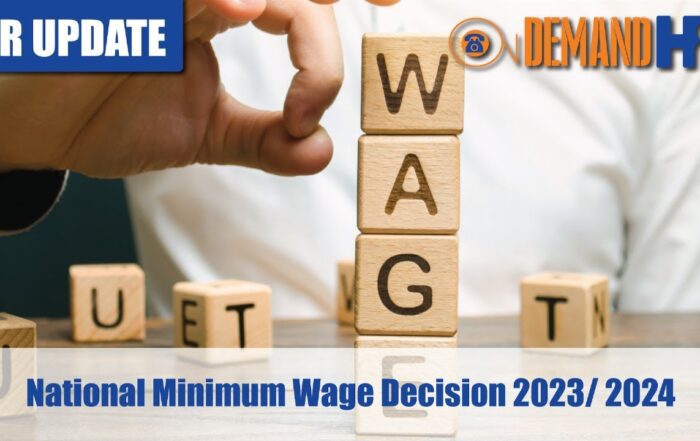Negotiating Effective EBA’s
In Episode 9 of HR Friday’s Clint reveals our template for planning and successfully negotiating effective enterprise bargaining agreements (EBA’s).
Please see below for a full transcript of the video
Share the HR or workplace relations challenge facing your business and one of our experienced consultants will be in touch within 24 hours with a strategic action plan or discover the best strategy yourself by accessing out free online training library.
Transcript
Clint Indrele 0:15
Good morning ladies and gentlemen, welcome to another edition of HR Fridays. My name is Clint Indrele Managing Director of On Demand HR. And every week at 11:30, we present a specific topic, please let us know any topics of interest that you may have in the future would be great for you to guide us on what you would like us to present on and look, please put some comments in the comments box during today’s presentation, we’ll be happy to take any questions that you have on the fly. The whole purpose of HR Fridays each week is to provide businesses, other organizations, professional advisors and our associate members with advice which is reality. We’ve been to the Fair Work Commission many times we’ve done many workplace investigations, we’ve dealt with the Fair Work Ombudsman many times. This allows us to provide real perspective, not just theory and scare tactics that you hear from a number of other consulting organizations, please visit our website www.ondemandhr.com.au.
Clint Indrele 1:16
Today’s topic is going to be about tips for making effective enterprise agreements. And we’re going to run through a few strategies and a few things that you should consider in undertaking these activities.
Clint Indrele 1:30
I’d like to start by talking about planning and looking at the first tip, which is early planning. And I like to think that this is important six to eight months prior to expiry. Okay. So first of all, a lack of planning for an enterprise agreement puts your business in reaction mode and weakens your negotiation position quite often, I see a number of organizations that have enterprise agreements in place and they basically wait for the union to get in contact with them to say, yeah, let’s negotiate an enterprise agreement. And they haven’t even given any thought to what it is that they want to achieve out of the Enterprise Agreement, what doesn’t work in the current enterprise agreement, and because of a lack of planning, they are just straightaway on the backfoot with these with these situations. So our recommendations in this regard, are review and consider what currently does not work well in the EBA, and consider what changes could be sought, remembering that not everything is going to be possible. This is why the whole art of making an enterprise agreement is so very important because committing to a particular term and condition of employment could be something that costs your business or your organization 10’s or hundreds of thousands of dollars in the long run. So mistakes in this game can be at significant cost. And once these things are in an enterprise agreement, they’re not necessarily going to be in fact, in most situations, the conditions in the agreement that you don’t like, particularly where there’s unions involved in the negotiations, are very, very hard to remove in future enterprise agreements, unless there are other things that offset those types of arrangements. So yeah, so look at what’s currently doesn’t work well in the EBA, consider what changes could be sought. Consider what your competitors have done or are doing, maybe have a look at other competitors, their enterprise agreements, or simply engage in conversations with them about how they’re approaching their enterprise agreement negotiations share information, that can also be very helpful in determining your strategy, anticipate the union claims that may be presented. So have a think in advance about what sort of things the union may very well put on the table. And no need to go into this into any great extent. But certainly having a think about what might be put forward based on you know, competitor information could be very important. Consider your communication strategies with employees and unions initially, including, you know, the compliance obligations, like putting out your notice of employee representational rights. The other thing that we also think is part of the planning process is actually starting to put together the new agreement skeleton. And what we like to do in the new agreement skeleton is take the existing agreement, and make all of the kind of if you like, administrative changes that you would like to introduce into the enterprise agreement. And then you can modify that document as you’re going through certain claims and certain issues raised by the union and being put forward by the company are being discussed. So I guess that is in summary, what we think a good early planning process for an EBA looks like and we recommend that you do this, as I said, about six, no less than six months prior to the expiry of your current enterprise agreement.
Clint Indrele 4:45
So we’ll move on to, I guess, our second set of tips around negotiation meetings. So this is once the parties are ready to negotiate, and the planning phase is completed. So we take the view that organizations and businesses should be on the front foot with these negotiations, rather than waiting for the union to make contact with the company about negotiating an EBA. Look, sometimes that might be an okay strategy depending upon the situation. But in most cases where you expect or where there’s a high expectation that there will be another enterprise agreement to follow the current enterprise agreement, often the best process is to simply reach out to the relevant parties to commence the negotiations. So and that’s why the the planning is important, because you want to be doing that prior to reaching out to those parties. Consider, obviously, the union’s log of claims assuming unions are involved in the matter. Allow yourself at least one to two weeks to respond, don’t feel compelled to respond to a log of claims straightaway. It is very important that you allow yourself the necessary time to consider things like costings associated with various claims. Remember that negotiations are not just about the headline increase. And often the way that the unions will present their claims is a headline pay increase plus a range of other conditions, which ultimately cost. So you know, agreeing to a 3% increase or a 2% increase or whatever it is the increase you’re agreeing to. Ultimately, the real cost depends on the cost of the other claims. So the cost of the other claims could be quite significant could add an extra one to 2% to the the overall increase in your wages bill. So be very clear on costings. Remember that negotiations is more about than just a headline increase. And as we mentioned, in the previous set of tips, mistakes, or complacency can be at significant cost hundreds of thousands of dollars a mistake in a enterprise agreement can cost you. Be very clear on the relevant business and economic environment. And sometimes I have struggles with clients on this because they don’t want to share information with unions, they don’t want to share information with employees about these particular situations. So I think that’s the wrong approach. Because I think that there’s nothing better for a negotiation, then to lay out the narrative or the economic and business environment. Particularly if it’s a challenging one, if the environments challenging, if your business isn’t running at a at a loss, or at a profit should I say, or if your business is you know, in a breakeven situation, or you’re in a scenario where there are massive challenges as a result of, you know, COVID-19, and things like that, share that information with with employees and unions, make them understand the negotiating context that this enterprise agreement will need to be discussed in. So after that one to two weeks to consider the union’s lof of claims, we recommend that you provide some sort of a response. And we think that you do this by way of a presentation to the unions, or to the unions, and obviously, any employees that are negotiating directly. And what we recommend that you include in this presentation is a response to the log of claims. But also an overview of the relevant business and economic environment for obviously, that organization. So that gives you the ability to respond. And to say, this is why we’re responding in this particular way and providing justification as to why you may have certain positions on certain claims. We think it’s also good to kind of break down in your log of claims, each one of the claims and talk about you know why a certain change is justified or isn’t justified, it can be a financial reason. But it can also be because other parts of the Enterprise Agreement already adequately deal with that particular issue. Or, it could be simply the case that you don’t feel that a particular claim is justified in the context of what’s already in the enterprise agreement, or what competitors are doing or what’s already in NES, and so on. So there’s all there’s a range of different ways of responding to look at claims that’s been provided by the union. And we sort of recommend that you work through those things, present to the unions and talk about that relatively early in the piece, probably the second or third meeting, negotiation meeting that you are having. So that’s our kind of second set of tips around negotiation meetings themselves. And hopefully, there’s something that you’ve got out of that in terms of useful information for your upcoming enterprise agreement.
Clint Indrele 9:19
We then move on to I guess, moving the EBA to conclusion. So this can be a challenge often where the parties are just tooing and froing, and tooing and froing and tooing and froing. And, you know, arguing about details or, you know, continuing to waste time on on small details. So, our view on how to move the enterprise agreement along in a, you know, you know, in a timely manner, is yes provide your response to the union log of claims, as we mentioned in the previous slide, as part of your company presentation. But suggest that the agreement skeleton be provided in the near future, to the unions and their employee representatives if the timing of course is appropriate. What that kind of does is moves things along it gives it gives the union the ability to then consider the agreement, come back with any issues that they may wish to raise about the new document. Obviously, if you’ve got an existing document, that should always be the starting point for the new document. Rewriting a document from scratch is often going to slow things down, it’s often going to create a situation where the union’s going to be more skeptical about the content in the agreement, and so on and so forth. So yes, certainly, if you have an existing agreement, use that as the foundation for the new agreement, make the administrative changes you obviously feel are necessary to make. The other thing that we suggest is certainly looking at the increases and how you might avoid that and we say to avoid backdating of increases. So increases in enterprise agreements are inevitable, but the backdating of increases is something that I find that companies just roll over far too easily. And and what we find that often does is creates a situation where the union’s then don’t really have an incentive to want to close the negotiation in any in any kind of timely manner, they will simply wait around for certain claims. And, you know, continue on with frivolous arguments on certain things. And you want to create this kind of cultural negotiating environment where, really, the quicker that the deal is done, the quicker that the new rates will come into play. So we say that look, and you shouldn’t be bacdating increases to anything earlier than at least a positive vote, being carried by the employee. So again, eliminate the the incentive for the delay. So make the incentive to reach agreement as quickly as possible. Obviously, then you need to consider all of your lodgement requirements and consider those logic requirements in advance, you’re going to have to consider them in advance because sometimes, and take this from personal experience of years and years gone by when you know, I’ve started doing enterprise agreements myself, but consider the lodgement requirements in advance. There quite a number of them, have a look at your form F16. Form 17, on the Fair Work Commission’s website. Look at things like it, and the standard requirements are explaining the new EBA to employees. So you must provide a communication piece at the very least around that that is actually one of the obligations. And one of the questions you’ll be asked in lodgement. You need to make sure that you properly notify the voting arrangements and the method of the voting. And you need to complete obviously, the forms, you need to have signatories on the EBA, the capacity of those signatories, and so on and so forth. The other thing that we recommend is look appoint someone a bargaining representative, either internally or externally, preferably to assist in the negotiations and move things along. One thing we find with enterprise agreements is that if you’re relying on someone within the company to drive the whole process, that can often be a stumbling block in and of itself, because they are caught up on obviously, all of the day to day operations of their particular area. And look, most of the clients we deal with, you know, have less than less than kind of 3,400 employees. So at best, you’re talking about maybe one HR manager, or you might have situation in a smaller, you know, environment of less than 100 employees where there’s no HR manager at all. So having an external party to move things along, to write the skeleton to make sure the compliance obligations are met, to keep the parties focused on the key things is very, very important. And really what you want to do with the internal company representatives, is give them the decision making power, you know, what sort of increase? what claims we’re going to accept? explain the options for those claims. And that gets them to focus on the key things that they really should be contributing to, but taking away the administrative and technical burdens of running an EBA process. So another important point. And finally lodging the enterprise agreement with the Fair Work Commission and responding to often the queries that come back from, you know, the commissioner, or the deputy president or their associates in that regard. So quite often with enterprise agreements these days, we find that you know, most will come back with, the Commission will often come back with questions, they’ll come back with, you know, certain comments, and it’s very, very common that you’ll have to provide some sort of undertakings about one or two particular items, regardless of how well you’ve planned your enterprise agreement, there’s always seems to be one or two small things that the Commission will pick up on. So and look, we’ve experienced that in recent times as well. So that is really, I guess, a good understanding or framework of around how do we move the EBA from kind of negotiation phase to conclusion phase and there’s some there’s some useful tips and strategies in doing that. So I guess that’s really a wrap up of the the third set of tips around moving the enterprise agreement to conclusion.
Clint Indrele 15:00
So I guess we’ll just as a final part of today’s segment, I really just wanted to say overall with enterprise agreements, look, there is some other things that businesses might want to consider in these particular COVID-19 times, there’s certainly opportunities to achieve longer deals. At the moment, what we are finding is that obviously wage increases, if you look at the Fair Work Commission’s decision, it was 1.75% for 2020. And that was phased in on a delayed basis. So you had some increases coming in first July, some first November and some first of February. So if you’re going to an enterprise agreement with increases that are above that, there’s a reasonable chance that you can get a you know, longer term of agreement, in order to obviously lock in costs and so on. And I ask businesses to also consider, you know, what, what might increases be in 2021 2022? In terms of the Fair Work Commission, how is the offering that you’re going to put forward now going to compare against that? And can we get, you know, a reasonable outcome now for longer, then if we get a shorter outcome that might, that might create higher, you know, potential increases later on down the line? So, some number of considerations there to think about.
Clint Indrele 16:25
So I think I’ll just leave it at there for this week. In terms of enterprise agreements, and our HR Friday segment. I hope you’ve really enjoyed today’s session. And if you have any further questions on enterprise agreements, please get in touch with us at www.ondemandhr.coom.au. If you are coming up to an enterprise agreement yourself, and you want some assistance with that process, please reach out to us we are very experienced in conducting these processes. We have been recently getting a number of enterprise agreements through the Commission so we know what it takes that we have what it takes to get these things done in a timely manner, with good business outcomes. So we’ll leave it there. Thank you very much. Once again, my name is Clint Indrele, Managing Director of On Demand HR hope you enjoy your weekend and we look forward to having you again next week, same time Friday 11:30 for another edition of HR Fridays.






